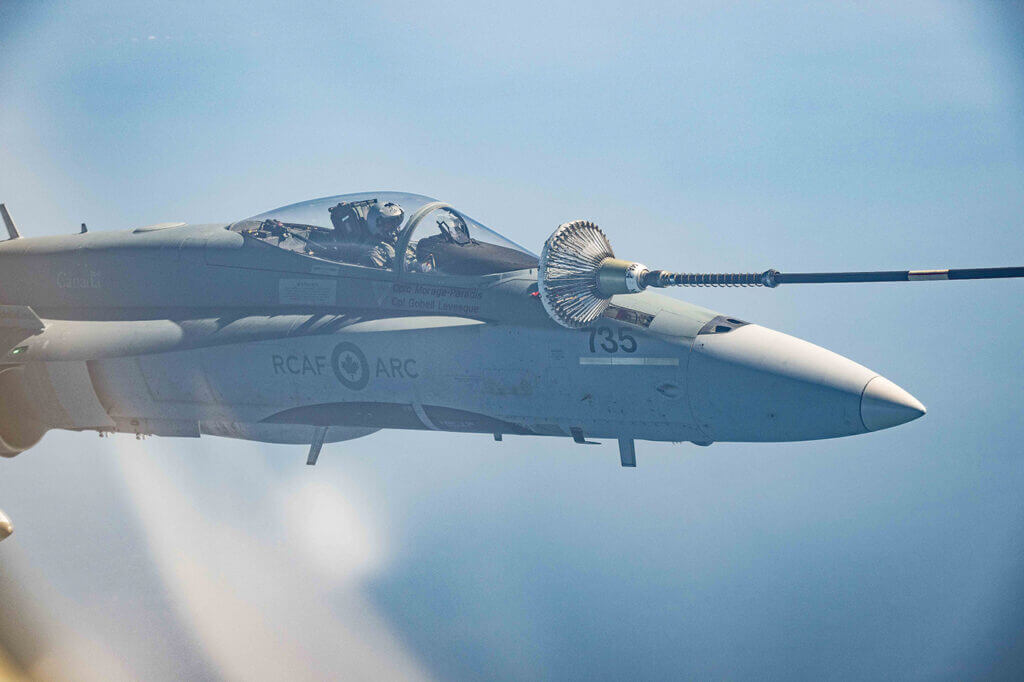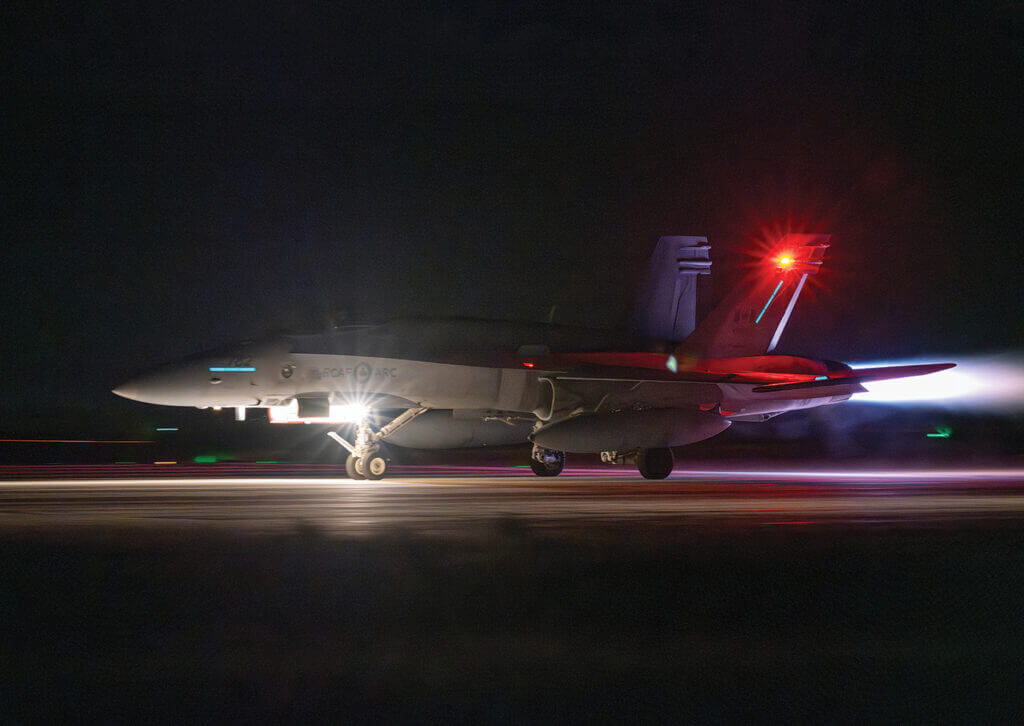Estimated reading time 13 minutes, 49 seconds.
Cobra Warrior is a United Kingdom-led and hosted biannual exercise that attracts a varied range of participants from across the globe.
The most recent iteration, Cobra Warrior 23-2, ran for three weeks throughout September and drew attendees from the Royal Air Force (RAF), Royal Norwegian Air Force (RNoAF), United States Air Force (USAF), Italian Air Force, NATO, and first-time participants, the Royal Canadian Air Force (RCAF).

While many international exercises such as Red Flag are hosted at one location, Cobra Warrior sees aircraft and personnel deployed across the UK. RAF Mildenhall was home to Norwegian F-35s and USAF F-16CJs, while RAF Leeming accommodated USAF HH-60G Pavehawks. The RCAF detachment was split between RAF Lossiemouth and RAF Waddington, which also housed NATO E-3 aircraft.
The Canadian air task force consisted of seven CF-18 Hornets flying from Waddington and one CC-150T Polaris, providing aerial refuelling, at Lossiemouth. Approximately 140 personnel including maintenance technicians, operations, intelligence analysts and public relations supported the deployment. Several aerospace controllers worked alongside their RAF colleagues at RAF Boulmer and its Air Surveillance and Control System (ASACS), used to monitor and defend U.K. airspace.
Each year, the RCAF receives numerous exercise invitations and often seeks out those with the best training value. Though first-time participants to Cobra Warrior, the benefits of the multinational event ranged far and wide, explained Lieutenant-Colonel Tom Lawrence, the air task force commander, and the Commanding Officer of 433 Tactical Fighter Squadron (TFS) at 3 Wing Bagotville, Quebec.

“In my time flying fighters, I have never come to England with the jets and participated and worked so closely with the RAF,” he said. “For us at the tactical level, it was something new. The exercise staff had put together what we thought was a great training package for the pilots and air weapons controllers.
“[Cobra Warrior] afforded us the opportunity to go somewhere new, integrate with different forces and learn in an environment that was going to give us mission scenarios that were representative of real-world operations,” added Lawrence, an experienced Hornet pilot with 17 years on the aircraft.
International training deployments also carry strategic objectives. At a time of year when a fighter squadron has been deployed in Romania, conducting NATO air policing, under Operation Reassurance, the Canadian Armed Forces deterrence mission in Europe, collaborating with allies as a large fighter force sends a significant message.
“At the strategic level, sending Hornets to Europe is a statement in itself,” said Lawrence. “It demonstrates Canada’s commitment not only to NATO, but to all our allies around the world that Canada is committed, and we are here.

Op Reassurance, an initiative first established in response to the 2014 Russian annexation of Crimea, includes a Canadian Army-led multinational battlegroup in Latvia, Royal Canadian Navy vessels patrolling the Mediterranean Sea and Black Sea, and an RCAF air mobility detachment operating from Prestwick in the U.K, providing transport of donated equipment and weapons to Ukrainian forces.
“With the events in Ukraine over the last year and a half or so, it is important for us to reaffirm that message,” he said. “What better way to do that than to send military equipment and train with our allies so that we’re all ready for any contingency.”
Countering state aggression
With European security facing its toughest test of solidarity arguably since the Second World War, it is perhaps no surprise that the focus of Cobra Warrior 23-3 was on countering state-on-state aggression. Developed by 92 Squadron RAF, Cobra Warrior portrayed a “situation that changed dynamically day to day based on the results of each mission. We were given a scenario to work within and apply critical thinking and solve [tactical] problems,” said Lawrence.
The first week of the exercise saw participants respond to, and defend against, a surprise attack on a fictional European nation. During this opening stage, Canadian Hornets conducted defensive counter-air missions, aiming to protect a list of strategic targets or high value airborne assets.

Moving into the second week, the focus shifted to air-interdiction/strike missions as the hypothetical campaign shifted from defence to offence, with Scotland standing in for enemy territory. During this phase participants simulated dropping air-to-ground weapons while USAFE (United States Air Forces Europe) Suppression of Enemy Air Defenses (SEAD) specialists, the 480th Fighter Squadron, engaged simulated surface-to-air missile sites.
The third and final week introduced contingency operations, specifically personnel recovery. These sorties simulated that a pilot had been forced to eject over hostile territory and would need to be located and extracted. CF-18s flew combat air patrols (CAP) providing aerial cover for USAF HH-60G Pavehawks from the 56th Rescue Squadron tasked with recovering the downed aircrew.
As a large, multinational exercise, Cobra Warrior presented training opportunities for the entire Canadian detachment. “We don’t really get the opportunity to participate in an exercise of this scale very often,” said Lawrence, “so when it does happen, you really want to maximize the training for everyone. As the Commanding Officer, one of my objectives is to give that opportunity to everybody.”

Junior pilots were able to experience multi-asset scenarios, far larger than the small packages flown at home. These assets brought together a slew of different capabilities — rotary wing, airborne early warning and fighters — testing their ability to maximize their effectiveness and to solve tactical problems. Training like this helps build the skills of young crews so that when/if they are deployed on real-world operations, they are used to working and planning with different nations to accomplish their mission, Lawrence explained.
For new CF-18 pilots like call sign “Penguin,” Cobra Warrior was an opportunity to hone tactics based on lessons learned from the recent conflict in Ukraine.
“Over the past couple of years, there’s been a lot of new threats and TTPs (tactics, techniques and procedures) that we’re observing. We have to validate our own training and tactics against that,” he said.
A member of 433 Squadron for just under two years, Penguin completed his fighter-lead-in training at the Euro-NATO Joint Jet Pilot Training (ENJJPT) program at Shepherd Air Force Base, Texas, and his conversion training to CF-18 at 4 Wing Cold Lake, Alberta.
The exercise provided an opportunity to learn how allies are answering those same threats and exchange ideas to take home and, in turn, use operationally. It also allowed the 433 Squadron to integrate with fifth-generation F-35s of the RNoAF, the aircraft which will replace the CF-18 Hornet.
During fighter integration sorties, both nations’ aircrews maximized their effectiveness by drawing on the strengths of each platform. “We really got to see how they use their sensors and what information they can give us. We didn’t get the full depth of learning about the F-35, but we got some really good exposure,” said Penguin.
Flying alongside Norwegian pilots wasn’t new. A classmate at ENJJPT was from Norway and was present at Cobra Warrior. “The last time I flew with him was on pilot training in Texas, and there I was over the North Sea with my F-35 buddy covering me,” he said. “That’s pretty cool!”

It wasn’t just the 433 pilots who benefitted from the complexity and operational pressures of Cobra Warrior. “One of the first things I told the group when we arrived [at Waddington] was to be prepared for friction. Be prepared for things to be a little bit difficult and that’s okay That is the same friction we are going to experience when we are on operations,” said Lawrence.
NATO doctrine means it is highly unlikely that any nation would fight or deploy alone, regardless of whether Article 5 had been triggered. One of the primary objectives of the exercise was to further interoperability. Throughout the training, participants were forced to come together to solve tactical problems with the limited resources available.
“Different nations operating different aircraft had to work together and find a solution. They then had to prove that solution to a commander, who was then willing to take that risk and give you the green light to go ahead and fly it,” he said.

Interoperability can often be taken for granted at the beginning of an exercise like Cobra Warrior, Lawrence noted. It is critical participants learn not only each other’s strengths, but also their limitations.
“Results sometimes come back unfavourable for the first couple of days and then people really buckle down and start getting to work. Typically, the trend then is to greater interoperability and better plans that properly account for what assets can or can’t do.”
Throughout the second and third weeks of Cobra Warrior the operational intensity was ramped up, increasing the pressure on personnel and aircraft alike. Crews committed upwards of 24 hours to planning, briefing, and debriefing sorties which may have only lasted two to three hours. Working days of 12 to 14 hours were not uncommon.

Aircraft technicians also put in the hours ensuring there were enough Hornets on the line to meet daily taskings. It is a credit to them that at the time of RCAF Today’s visit, no sorties had been cancelled due to serviceability issues. “We have a lot of really good technician support. I’ll park up the jet and within a couple of seconds everything is ready [to start servicing the aircraft] and the jets are ready to be flown again in no time,” said Penguin. “The technicians are really putting in extra effort.”
A stellar experience
To a casual observer, bringing together nations whose first language is not English and asking them to participate in complex aerial activity may seem like a recipe for confusion. However, thanks to NATO’s standardized practices, communication, basic tactics and procedures are well known to participants. “This allows us to start planning and working together right off the bat,” explained Lawrence.
One interesting challenge all participants had to overcome was how the geographical spread of deployed assets would impact mission planning. Not only did communication need to be established with all detachments, it also needed to be secure at a classified level.

“It’s another aspect of this exercise that is hard to replicate back home,” he noted. “To me, it was the biggest challenge because it doesn’t always work.”
Although communications were reliable, there were instances when participants “dropped out” of mission planning calls. Lawrence elaborated: “We could be planning with a four-ship of F-16s that are slated to provided escort support for us the next day, but we can’t get them online. How are we going to proceed with the plan?
“Sometimes it does fall back to standards and expectations. If I was in their shoes this is what I would want them to do.” Those frictions added another valuable level of training, as just in real-world situations mission commanders were forced to adapt
and compensate.

Gratifying to note that ENJJPT really worked. I was the Canadian Euro NATO Training member who helped setup the program back in the early eighties and sold the program to our Senior Air Staff. Shepherd AFB in Texas was viewed as an interim solution which in time transfered to Canada.